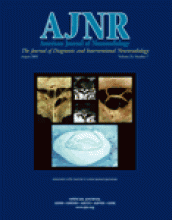The article by Friedman and Maitino (1) that appears in this month’s AJNR is quite timely. The authors demonstrate the low rate of neurovascular sonography performance by academic neuroradiologists (11%) who are responsible for the training programs for neuroradiology fellows. When the program directors (PDs) of neuroradiology fellowships are therefore required to ship their fellows off to other services either within the department of radiology or with other departments in the hospital for this training, there is little accountability for the quality of this training. This has led to a strong sentiment for revoking the 2-week neurovascular sonography requirement defined by the Accreditation Council for Graduate Medical Education (ACGME) standards for neuroradiology fellowships (“2–4 weeks or equivalent dedicated experience performing and interpreting vascular sonography,” from the www.acgme.org website).
The paradox is Friedman and Maitino’s finding that, in 53% of private practice settings, neuroradiologists are engaged in performing neurovascular sonography. Although this number seems surprisingly high, the authors investigate in a somewhat superficial manner the total volume of cases performed by neuroradiologists and conclude that they account for 32% of the cases performed by radiologists in general or 15% of carotid sonography procedures performed throughout the private institutions. At both the academic centers and the private practice settings, nonradiologists perform a substantial number of the carotid sonography examinations (58% and 42% respectively). The workload is largely performed by vascular surgeons, neurologists, and cardiologists.
A 2003 American Society of Neuroradiology (ASNR)–sponsored Internet survey of fellowship PDs and ASNR members on attitudes toward neurovascular sonography produced similarly interesting results. Seventy PDs and 464 ASNR members responded, representing 77% of program directors and approximately 16% of the ASNR, respectively. Thirty-nine percent of PDs and 29% of members surveyed said the sonography requirement should be completely eliminated from the fellowship program. Fifty-one percent of PDs and 57% of members thought sonography should be recommended, but not required, during fellowship training. Only 10% (7/70) of PDs and 14% (63/464) of ASNR members felt that sonography should be a required element of neuroradiology fellowship training. In summary, 90% of PDs and 86% of members thought that the ACGME criterion of mandating 2 weeks of neurovascular sonography training should be removed.
In the ASNR survey, only 9% of fellowship PDs and 35% (166/464) of members surveyed performed neurovascular sonography as part of their practice. Of the 166 physicians who performed neurovascular sonography, 84% stated that it constituted <5% of their practice, whereas the remaining 16% said it constituted only 5–25% of their practice. In no instance did neurovascular sonography exceed 25% of the work currently performed.
Twenty-six percent of the 464 members said neurovascular sonography training was not applicable in their practice, 33% felt it was minimally applicable, and 24% found it somewhat applicable. Fourteen percent thought it was very applicable, and only 2% thought sonography was critical to practice. In summary, most (94%) trained neuroradiologists thought neurovascular sonography training had little role in their practice (65% who do not perform sonography at all and 29% for whom it represents <5% of their casework). Thus, sonography represents >5% of practice for only 5.6% of neuroradiology fellowship program graduates. Many respondents also thought that the training in residency was sufficient.
But there is a dilemma. The American College of Radiology (ACR), in an effort to preserve the turf of neurovascular sonography for radiologists, would delight in supporting neuroradiologists as the champions of neurovascular imaging. After all, we have mastered the technical challenges of CT angiography (CTA), MR angiography (MRA), and digital subtraction angiography. We know the vascular anatomy of the neck and brain better than any other specialists in radiology. By keeping neurovascular sonography under the rubric of neuroradiology and making its training a requirement in a certificate of added qualification program, the ACR can solidify radiology’s claim to this technique.
Vascular surgeons and cardiologists undoubtedly covet this diagnostic procedure, and neurologists likewise also desire to plant a flag in a “procedure” that yields more revenue than their lengthy neurologic examination.
Nonetheless, most neuroradiology PDs have ambivalence about the technique. Although we see its value, we are much more concerned about teaching our trainees about more “relevant” newer radiologic techniques such as CTA, MRA, diffusion imaging, perfusion imaging, MR spectroscopy (if only it would be reimbursed by Medicare again!), functional imaging, and positron emission tomography. Most wish to do away with the 2-week requirement and allow the PDs to decide how and what to train their fellows.
On February 18, 2003, we won the battle. The Radiology Residency Review Committee (RRC) of the ACGME, responding to a request made by the PDs and the President of the American Society of Neuroradiology, elected to rescind the requirement for 2 weeks of neurovascular sonography training in the 1-year neuroradiology fellowship. The RRC presumably accepted the argument made that the training in neurovascular sonography one receives, as part of the 4-year radiology residency, was sufficient to practice this technique effectively. A struggle that has been 3 years in the making was “successfully” concluded. Was this the correct road to take? How many neuroradiology PDs will continue to provide fellows with the extra time to perfect neurovascular sonography, now that it is no longer required? Have we abandoned one frontier to nonradiologists? Can we continue to claim to be the experts in the field?
- Copyright © American Society of Neuroradiology












